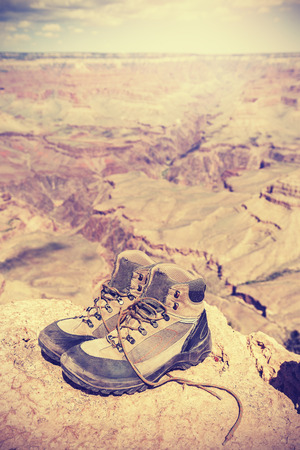Understanding Flash Floods
Flash floods are sudden, intense floods that occur within a short period of time—often just a few minutes or hours—after heavy rainfall or the rapid melting of ice. These floods are especially dangerous because they can happen with little warning, catching hikers and outdoor enthusiasts off guard. In popular American hiking spots, such as the slot canyons of Utah or the rugged trails of the Southwest, the geography often funnels rainwater from distant storms into narrow gullies or dry creek beds. This means even if it’s not raining where you are, a storm miles away can unleash a wall of water that surges through these areas with incredible force. The speed and unpredictability of flash floods make them a significant risk for anyone exploring America’s natural landscapes, emphasizing the importance of understanding local weather patterns and recognizing early signs of danger while on the trail.
Popular U.S. Hiking Destinations at Risk
Many of America’s most beloved hiking locations are also some of the most vulnerable to flash floods. This is due to their unique geography, seasonal weather patterns, and the growing popularity of outdoor recreation. Understanding which destinations carry the highest risk helps hikers plan safer trips and take appropriate precautions.
Top Flash Flood-Prone Hiking Spots
The United States offers a vast array of scenic trails, but certain areas stand out for their susceptibility to sudden flooding events. Below is a comparison of several iconic hiking destinations where flash floods are a significant concern:
| Hiking Destination | Location | Flash Flood Risks | Key Features |
|---|---|---|---|
| Grand Canyon National Park | Arizona | Canyon walls channel water quickly; storms can cause rapid rises in water levels. | Steep terrain, slot canyons, desert climate. |
| Zion National Park (The Narrows & Slot Canyons) | Utah | Narrow canyons fill rapidly; little time to escape rising waters. | Narrow slots, sandstone formations, dramatic elevation changes. |
| Appalachian Trail (especially southern sections) | Eastern U.S. | Torrential downpours cause creeks and rivers to overflow with little warning. | Diverse landscapes, forested paths, high rainfall areas. |
Why These Areas Are High-Risk
Certain environmental factors make these locations particularly hazardous during storms. The Grand Canyon’s steep cliffs and narrow side canyons allow rainwater from distant storms to funnel rapidly into hiking routes. In Zion National Park, especially in The Narrows and other slot canyons, there may be no visible clouds overhead—yet rain miles away can send torrents through the canyon with little notice. Meanwhile, the Appalachian Trail weaves through regions prone to heavy rainfall and flash flooding, particularly in low-lying valleys or stream crossings.
Local Culture and Outdoor Preparedness
Hiking culture in the U.S. emphasizes personal responsibility and preparedness. Park rangers and local guides frequently educate visitors about checking weather forecasts and understanding posted flood warnings before venturing out. Many American hikers use apps or follow social media alerts specific to each park or trail system, reflecting a community-wide commitment to safety and respect for nature’s power. By staying informed about which destinations are most at risk for flash floods, hikers can better protect themselves while enjoying the country’s breathtaking wilderness areas.

3. Recognizing Warning Signs and Weather Patterns
When hiking in popular American destinations, understanding both natural and man-made warning signs is crucial for flash flood safety.
Natural Warning Signs
Nature often gives early clues before a flash flood strikes. Watch for rapidly darkening skies, distant thunder, or sudden changes in wind patterns. Rising water levels in streams—even if rain is falling miles away—can signal that a flash flood is approaching. Unusual debris like twigs or leaves flowing downstream may also indicate water is rising upstream.
Man-Made Warning Systems
The United States has robust alert systems to keep hikers informed. Trailheads often feature posted notices about recent weather events or current risks. Pay attention to these signs as they are updated by park rangers and local authorities. In some high-traffic parks, electronic boards display real-time alerts and emergency instructions.
Interpreting Watches and Alerts
The National Weather Service (NWS) issues different types of alerts: a Flash Flood Watch means conditions are favorable for flooding; a Flash Flood Warning means flooding is already happening or will happen soon in the area. Always check your route with the NWS website or trusted weather apps before heading out, and sign up for local alert services where available.
Key Indicators to Monitor While Hiking
- Sudden drop in temperature and increased humidity
- Clouds building quickly over mountains or canyons
- Muddy water flowing where it was previously clear
- Loud rumbling sounds coming from upstream, indicating moving rocks or debris
Cultural Note:
In many U.S. hiking spots, it’s common courtesy to share information about changing weather conditions with fellow hikers you meet on the trail. This sense of community helps everyone stay safe and enjoy America’s natural wonders responsibly.
4. Flash Flood Preparedness and Planning
Flash floods can occur with little warning, especially in popular American hiking destinations such as Zion National Park, the Grand Canyon, and Yosemite. Proper preparedness and planning are crucial for ensuring your safety during outdoor adventures. Before setting out, hikers should take several practical steps to minimize risk and increase awareness.
Trip Planning Essentials
- Choose Safe Routes: Research trails ahead of time, and avoid those known for narrow canyons or low-lying areas prone to flooding.
- Inform Others: Always let someone know your hiking plan, including your route and expected return time.
Checking Weather Forecasts
Staying updated on weather conditions is vital. The U.S. National Weather Service provides real-time alerts for flash flood warnings. Before leaving home or your lodging, check:
| Weather Source | What to Look For |
|---|---|
| National Weather Service (NWS) | Flash Flood Watches/Warnings |
| NPS Official Websites | Trail closures & local advisories |
| Weather Apps (e.g., AccuWeather, Weather Channel) | Hourly rainfall predictions |
Understanding Emergency Procedures in U.S. Parks
Familiarize yourself with park-specific emergency protocols. Most U.S. national parks post emergency instructions at trailheads and visitor centers. Key steps include:
- Identify Shelter Locations: Know where high ground is located along your route.
- Emergency Contacts: Save the parks emergency number in your phone and carry a printed copy.
- Evacuation Routes: Learn the nearest exits and evacuation paths before you begin hiking.
Packing a Flash Flood Kit
- Poncho or rain jacket
- Whistle for signaling
- Headlamp with extra batteries
Pro Tip: Practice “Leave No Trace” Principles Even in Emergencies
If you need to move quickly due to an approaching flood, remember to pack out all trash and leave natural spaces undisturbed whenever it’s safe to do so.
5. What to Do During a Flash Flood
When a flash flood strikes while you’re hiking in America’s wild places, knowing exactly what to do can save your life. Here’s culturally relevant advice for immediate action:
Seek Higher Ground Immediately
The number one rule is to move to higher ground as fast as possible. In American wilderness areas, this often means climbing up rocky outcrops, hills, or even large boulders. Avoid staying in washes, canyons, or riverbeds—even if they look dry.
Avoid Crossing Water
Never attempt to cross flowing water. In the U.S., just six inches of moving water can knock an adult off their feet, and two feet can sweep away a vehicle. Look for alternative routes along ridges or elevated trails that are common in popular parks and preserves.
Be Aware of Local Hazards
American hiking spots often have warning signs or posted evacuation routes—pay close attention to these. In places like Zion National Park or the Grand Canyon, rangers may also provide real-time updates; listen to them if possible.
Don’t Wait—Act Fast
Flash floods move incredibly quickly. If you hear roaring water, see debris flows, or notice a sudden rise in water level, don’t hesitate. Move immediately and encourage others around you to do the same.
Call for Help if Needed
If you’re trapped, try to get cell service from higher ground and call 911. Use location apps or emergency beacons common among American hikers to communicate your position if you have them.
Your best chance of staying safe is through quick thinking and taking advantage of the unique features and resources available in American wilderness areas. Always prioritize your safety over personal belongings during a flash flood event.
6. Environmental Impact and Recovery
Ecological Effects of Flash Floods
Flash floods dramatically reshape the landscapes of America’s favorite hiking destinations, from the canyons of Zion National Park to the trails of Yosemite. These sudden surges of water erode soil, uproot vegetation, and redistribute rocks and debris, often leaving behind altered riverbanks and washed-out paths. Local wildlife is also affected—burrowing animals may lose their homes, aquatic life can be swept away, and nesting sites are sometimes destroyed. Sensitive plant species might struggle to recover, while invasive plants may take advantage of newly disturbed ground.
Wildlife Disruption
The aftermath of a flash flood disrupts the natural balance in these ecosystems. Animals may become displaced or stressed as food sources and shelter are reduced. Birds that nest along riverbanks or mammals that rely on stable terrain for dens find themselves especially vulnerable. Over time, resilient native species usually adapt, but repeated disturbances can tip the ecological scales in favor of non-native plants and animals.
Responsible Hiking After a Flood
If you’re planning to hike in areas recently hit by a flash flood, it’s important to practice responsible behavior to support recovery:
Stay on Marked Trails
Floodwaters often weaken or alter trails. Stick to official paths to avoid trampling fragile regrowth and prevent further erosion.
Avoid Disturbed Areas
Give damaged riverbanks and mudslides time to heal by steering clear of visibly affected zones. This helps prevent further destabilization and protects recovering habitats.
Respect Wildlife Space
Keep a safe distance from wildlife that may be stressed or displaced by recent events. Avoid loud noises and sudden movements, which can further disturb them.
Leave No Trace
Packing out all trash, minimizing campfire impact, and avoiding picking plants are always good practices—especially critical after environmental disturbances when the ecosystem is most vulnerable.
Supporting Long-Term Recovery
Consider volunteering with local conservation groups or park services involved in trail restoration and habitat recovery efforts. Your participation helps ensure that America’s iconic hiking spots remain vibrant for both people and wildlife for generations to come.


